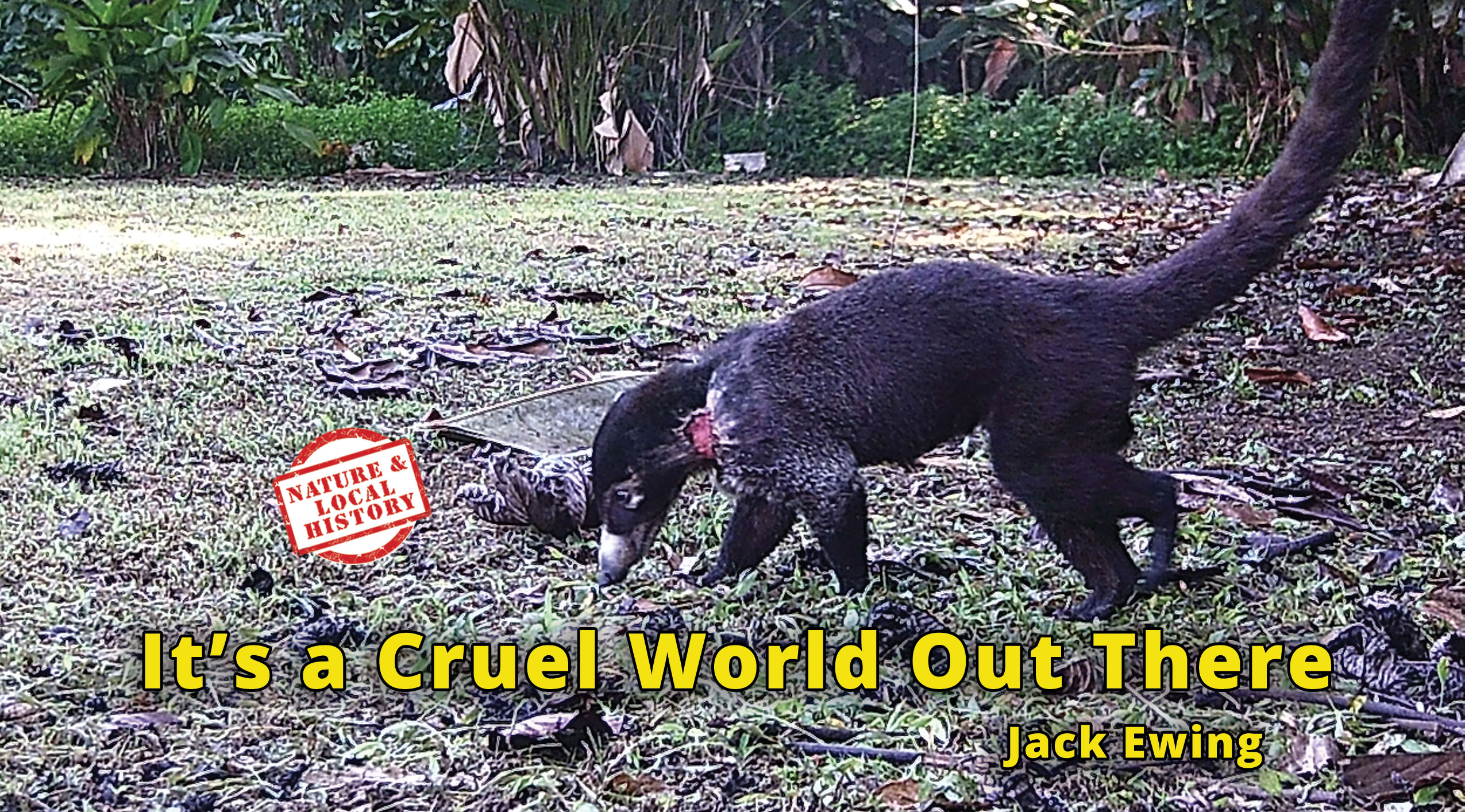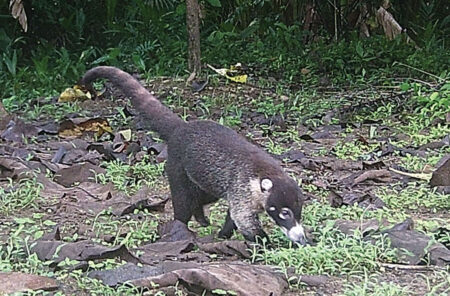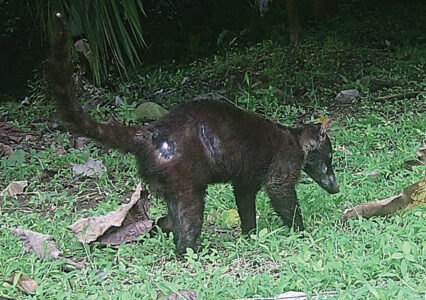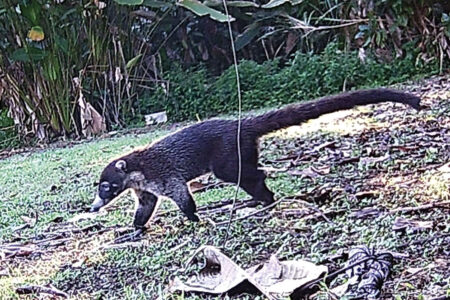Wounds, Scars, and Testosterone

 More information flows from trail cameras than I ever could have imagined back in 2011 when I started using them. Hiking or wandering through the rainforest is interesting whether or not you see any charismatic fauna of which there are 100s of species including anteaters, agoutis, all kinds of snakes, poison dart frogs, many different species of birds large and small, bright, and dull, and several species of carnivores. But how often do you see a jaguarundi, an ocelot, a tayra, or a puma? I recently retrieved and reviewed the memory card of a trail camera that was located at the edge of a swampy forest that bordered an open area. On the computer monitor I saw 11 different species of mammals, including three carnivores, six different birds, and one reptile. During the fifty years that I have lived near the rainforest I have seen all but one of the animals that were captured by the camera. But I had to walk 100s of hours to see some of them. Looking at the photos on that one camera taught me things and stimulated me to investigate things that otherwise would have taken me years to learn. Let me give you an example.
More information flows from trail cameras than I ever could have imagined back in 2011 when I started using them. Hiking or wandering through the rainforest is interesting whether or not you see any charismatic fauna of which there are 100s of species including anteaters, agoutis, all kinds of snakes, poison dart frogs, many different species of birds large and small, bright, and dull, and several species of carnivores. But how often do you see a jaguarundi, an ocelot, a tayra, or a puma? I recently retrieved and reviewed the memory card of a trail camera that was located at the edge of a swampy forest that bordered an open area. On the computer monitor I saw 11 different species of mammals, including three carnivores, six different birds, and one reptile. During the fifty years that I have lived near the rainforest I have seen all but one of the animals that were captured by the camera. But I had to walk 100s of hours to see some of them. Looking at the photos on that one camera taught me things and stimulated me to investigate things that otherwise would have taken me years to learn. Let me give you an example.
The memory card contained over 4500 photos all captured during the two months since I put it in the camera and flipped the “on” switch. As always, the first three photos were of me moving out of the field of view of the camera after turning it on. The fourth photo was a coati with a large wound on the side of its head. The quality of the photo was good, but even so I couldn’t be sure if the coati’s left ear had been torn off or not. As the wound healed more photos of the same animal appeared on the camera and it became obvious that the ear was still there right where it was supposed to be and in good shape. It was also clear that the wound was healing properly.
 During the previous year we had frequently sighted a large healthy adult male coati, in the prime of his life, within an area of a couple of square kilometers which included this camera and our house. We knew him and he knew us. If we were out for a walk and encountered him, he casually moved away but wasn’t alarmed. My wife Diane named him “Mr. Magoo”. About six months ago a strange thing happened. A second male coati started appearing in photos and videos from the same trail camera, but only at night. This one was smaller, thinner, and younger than Mr. Magoo. Seeing two male coatis in the same area was unusual, and I suspected that the younger one foraged mostly at night to avoid encounters with older males. He was probably recently separated from his mother. “Junior” seemed like an appropriate name for him.
During the previous year we had frequently sighted a large healthy adult male coati, in the prime of his life, within an area of a couple of square kilometers which included this camera and our house. We knew him and he knew us. If we were out for a walk and encountered him, he casually moved away but wasn’t alarmed. My wife Diane named him “Mr. Magoo”. About six months ago a strange thing happened. A second male coati started appearing in photos and videos from the same trail camera, but only at night. This one was smaller, thinner, and younger than Mr. Magoo. Seeing two male coatis in the same area was unusual, and I suspected that the younger one foraged mostly at night to avoid encounters with older males. He was probably recently separated from his mother. “Junior” seemed like an appropriate name for him.
 Male coatis are sometimes called coatimundis, and females are simply coatis. In Spanish males are called “Pizotes Solos” and females are simply pizotes. As you can guess by the name the males are almost always by themselves. The females, on the other hand, hang out in groups with everybody’s kiddos. Some of the bands are as large as 25 coatis. Many years ago, biologists thought that the solitary males and the bands of females were two different species. They even gave them different scientific names, Nasua solitaria for the males and Nasua sociabilis for the females. I guess that at some point somebody noticed that all the N solitairas had testicles and only the younger N sociabilis did. Less than half of the members in any given band were males. Today we know that the females stick together for protection from predators, the main ones being males of the same species, who will kill and eat the kits if they get a chance. A male coati wouldn’t hesitate to attack a lone female and kill her babies, but he wouldn’t attempt it with two or more females guarding the young.
Male coatis are sometimes called coatimundis, and females are simply coatis. In Spanish males are called “Pizotes Solos” and females are simply pizotes. As you can guess by the name the males are almost always by themselves. The females, on the other hand, hang out in groups with everybody’s kiddos. Some of the bands are as large as 25 coatis. Many years ago, biologists thought that the solitary males and the bands of females were two different species. They even gave them different scientific names, Nasua solitaria for the males and Nasua sociabilis for the females. I guess that at some point somebody noticed that all the N solitairas had testicles and only the younger N sociabilis did. Less than half of the members in any given band were males. Today we know that the females stick together for protection from predators, the main ones being males of the same species, who will kill and eat the kits if they get a chance. A male coati wouldn’t hesitate to attack a lone female and kill her babies, but he wouldn’t attempt it with two or more females guarding the young.
 When the male offspring reach about two years of age they separate from the band and try to make a go of it by themselves. I suspect that Junior came from a group that we occasionally see in the same area where Mr. Magoo hangs out. The fact that coatis are diurnal, and Junior was seldom seen during the day was more than likely because he was afraid of Mr. Magoo. During the mating season which occurs in January or February and lasts a couple of weeks, one or more males are allowed into the band to mate with the females. The females are dominant and when they finish mating, they give the males the boot. That is unless another female in the band is ready to mate. There can be vicious fights between competing males. The younger ones like Junior don’t have much of a chance of impregnating a female, but that doesn’t stop them from trying. Testosterone has been known to make males of many species do very foolish things, and I suspect that Junior is a victim of said foolishness. According to Mark Wainwright’s excellent field guide The Mammals of Costa Rica, studies show that serious scars are common among coatimundis as are damaged canine teeth. After reading that, I started paying close attention to every coatimundi that appeared on a trail camera, and I found that a high percentage will have some scars, more than those seen on other omnivores.
When the male offspring reach about two years of age they separate from the band and try to make a go of it by themselves. I suspect that Junior came from a group that we occasionally see in the same area where Mr. Magoo hangs out. The fact that coatis are diurnal, and Junior was seldom seen during the day was more than likely because he was afraid of Mr. Magoo. During the mating season which occurs in January or February and lasts a couple of weeks, one or more males are allowed into the band to mate with the females. The females are dominant and when they finish mating, they give the males the boot. That is unless another female in the band is ready to mate. There can be vicious fights between competing males. The younger ones like Junior don’t have much of a chance of impregnating a female, but that doesn’t stop them from trying. Testosterone has been known to make males of many species do very foolish things, and I suspect that Junior is a victim of said foolishness. According to Mark Wainwright’s excellent field guide The Mammals of Costa Rica, studies show that serious scars are common among coatimundis as are damaged canine teeth. After reading that, I started paying close attention to every coatimundi that appeared on a trail camera, and I found that a high percentage will have some scars, more than those seen on other omnivores.
Junior’s photo with a fresh wound on his neck was the first wildlife photo on the memory card from that camera. One of the last photos on that same card, taken nearly two months later, was also of Junior now all healed up. I wonder if he learned anything. I doubt it. Next time he catches a whiff of a female in estrus he will forget all the pain and humiliation of the last time he tried to challenge the big boys. At four to five years of age, he is likely to succeed at charming one of the ladies without acquiring any new scars.
